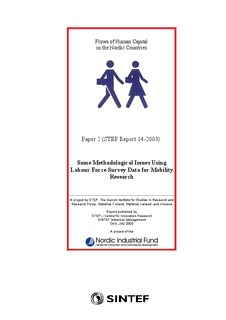| dc.contributor.author | Harðarson, Ómar | |
| dc.date.accessioned | 2014-12-23T10:26:16Z | |
| dc.date.available | 2014-12-23T10:26:16Z | |
| dc.date.issued | 2003-07-09 | |
| dc.identifier.isbn | 82-14-03207-5 | |
| dc.identifier.uri | http://hdl.handle.net/11250/273402 | |
| dc.description.abstract | The paper discusses the use of Labour Force Survey (LFS) data in mobility research. Design, conceptual, statistical, and other issues are addressed. Mobility figures emanating from Icelandic LFS and tax register data are then compared. These aspects of LFS data are of interest because they illuminate the differences between using survey data and register data in estimating mobility rates. The differences in actual numbers produced using the two types of data can be quite substantial. These methodological considerations are the output of a Nordic project which is dealing with the flow of human capital through job mobility in general, through researcher mobility in particular, and through migration between the Nordic countries. The project is jointly undertaken by STEP, The Danish Institute for Studies in Research and Research Policy, Statistics Finland, Statistics Iceland, and Vinnova. | nb_NO |
| dc.language.iso | eng | nb_NO |
| dc.publisher | SINTEF STEP Group | nb_NO |
| dc.relation.ispartofseries | STEP Report;14-2003 | |
| dc.rights | Navngivelse-Ikkekommersiell 3.0 Norge | * |
| dc.rights.uri | http://creativecommons.org/licenses/by-nc/3.0/no/ | * |
| dc.title | Some methodological issues using labour force survey data for mobility research | nb_NO |
| dc.type | Research report | nb_NO |
| dc.relation.project | Flows of Human Capital in the Nordic Countries. The Nordic Industrial Fund | nb_NO |

